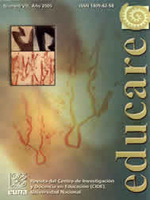Carta abierta a Hans Christian Andersen en el bicentenario de su nacimiento
DOI:
https://doi.org/10.15359/ree.2005-8.8Abstract
April 2nd, 2005 was a day for a double celebration: the bicentennial of the birth of Danish writer Hans Christian Andersen and the International Children’s Book Day. Andersen is known as the creator of contemporary children literature, for his fairy tales introduce language that at that time was used by adults only.
Students from Central American University (UCA) in Managua, Nicaragua, read an “Open Letter” during a Festival that the Books for Children Foundation organized in honor of the author along with the Norwegian and Danish embassies. The letter presents Andersen’s biography and explores alternative readings of his fairy tales from educational, psychological and psychoanalytical perspectives. The letter concludes with an interpretation of Andersen as a metaphor for the understanding and dialogue between Costa Rica and Nicaragua.
References
Andersen, H. C. (1989). El cuento de mi vida. La Habana: Editorial Gente Nueva.
Andersen, H. C. (1987). Cuentos de hadas para niños I. Madrid: Ediciones Gaviota.
Andersen, H. C. (1985). Cuentos de hadas para niños II. Madrid: Ediciones Gaviota.
Bettelheim, B. (1990). Psicoanálisis de los cuentos de hadas. Barcelona: Editorial
Crítica.
Bonning, B. (1996), Prólogo. En Cajón de cuentos, Hans Ch. Andersen. Santafé de Bogotá: Editorial Panamericana, pp. 7-17.
Cashdan, S. (2000). La bruja debe morir. De qué modo influyen los cuentos de hadas en los niños. Madrid: Temas de debate.
Cubero, J: (1987), "Hans Christian Andersen". En Cuentos de hadas para niños l. Madrid: Ediciones Gaviota: 7-21.
Departamento de Información (1997). Hans Christian Andersen. Copenhague: Real Ministerio de Relaciones Exteriores de Dinamarca.
Edmée Álvarez, M. (1986), "La vida y los cuentos de Hans Christian Andersen". En Andersen, H. C. Cuentos. México D.F.: Editorial Porrúa, pp. IX-XXVIII.
Marín, A. (1992), "Introducción". En La Bella y la Bestia y otros cuentos. Barcelona: Ediciones Gaviota, pp. 5-15.
Montes, G. (2001). El corral de la infancia. México D.F.: Fondo de Cultura Económica.
Nobile, A. (1992). Literatura infantil y juvenil. Madrid: Ministerio de Educación y Ciencia y Ediciones Morata.
Pardo Belgrano, R. y Nervi, J. R. (1979). Lexicón de literatura infantil juvenil. Buenos Aires: Editorial Plus Ultra.
Pascual, E. (Noviembre, 1997). "Un cuentista en la Corte del rey Sol". En Cuadernos de Literatura Infantil y Juvenil (CLIJ), año 10, número 99, pp. 8-23.
Propp, V. (1987). Las raíces históricas del cuento. Madrid: Editorial Fundamentos.
Revista Informaciones Danesas, (1985). "Hans Christian Andersen", en Cuentos de hadas para niños II. Madrid: Ediciones Gaviota, pp. 7- 21.
Ruzicka Kenfel, V. (Noviembre, 1996). "Clásicos de la literatura universal". En Cuadernos de Literatura Infantil y Juvenil (CLIJ), año 9, número 88, pp. 23-34.
Sandoval, C. (2003). Otros amenazantes. Los nicaragüenses y la formación de identidades nacionales en Costa Rica. San José: Editorial de la Universidad de Costa Rica.
Soriano, M. (1995). La literatura para niños y jóvenes. Guía de exploración de sus grandes temas. Buenos Aires: Editorial Colihue.
Published
How to Cite
Issue
Section
License
1. In case the submitted paper is accepted for publication, the author(s) FREELY, COSTLESS, EXCLUSIVELY AND FOR AN INDEFINITE TERM transfer copyrights and patrimonial rights to Universidad Nacional (UNA, Costa Rica). For more details check the Originality Statement and Copyright Transfer Agreement
2. REUTILIZATION RIGHTS: UNA authorizes authors to use, for any purpose (among them selfarchiving or autoarchiving) and to publish in the Internet in any electronic site, the paper´'s final version, both approved and published (post print), as long as it is done with a non commercial purpose, does not generate derivates without previous consentment and recognizes both publisher's name and authorship.
3. The submission and possible publication of the paper in the Educare Electronic Journal is ruled by the Journal’s editorial policies, the institutional rules of Universidad Nacional and the laws of the Republic of Costa Rica. Additionally, any possible difference of opinion or future dispute shall be settled in accordance with the mechanisms of Alternative Dispute Resolution and the Costa Rican Jurisdiction.
4. In all cases, it is understood that the opinions issued are those of the authors and do not necessarily reflect the position and opinion of Educare, CIDE or Universidad Nacional, Costa Rica. It is also understood that, in the exercise of academic freedom, the authors have carried out a rogorous scientific-academic process of research, reflection and argumentation thar lays within the thematic scope of interest of the Journal.
5. The papers published by Educare Electronic Journal use a Creative Commons License:















 The articles published by Educare Electronic Journal can be shared with a Creative Commons License:
The articles published by Educare Electronic Journal can be shared with a Creative Commons License: 



